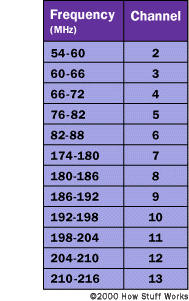How Cable Television Works
“
In the early 1950s, cable systems began experimenting with ways to use microwave transmitting and receiving towers to capture the signals from distant stations. In some cases, this made television available to people who lived outside the range of standard broadcasts. In other cases, especially in the northeastern United States, it meant that cable customers might have access to several broadcast stations of the same network. For the first time, cable was used to enrich television viewing, not just make ordinary viewing possible. This started a trend that would begin to flower fully in the 1970s.
The addition of CATV (community antenna television) stations and the spread of cable systems ultimately led manufacturers to add a switch to most new television sets. People could set their televisions to tune to channels based on the Federal Communications Commission (FCC) frequency allocation plan, or they could set them for the plan used by most cable systems. The two plans differed in important ways.
Advertisement
In both tuning systems, each television station was given a 6-megahertz (MHz) slice of the radio spectrum. The FCC had originally devoted parts of the very high frequency (VHF) spectrum to 12 television channels. The channels weren’t put into a single block of frequencies, but were instead broken into two groups to avoid interfering with existing radio services.
Later, when the growing popularity of television necessitated additional channels, the FCC allocated frequencies in the ultra-high frequency (UHF) portion of the spectrum. They established channels 14 to 69 using a block of frequencies between 470 MHz and 812 MHz.
Because they used cable instead of antennas, cable television systems didn’t have to worry about existing services. Engineers could use the so-called mid-band, those frequencies passed over by broadcast TV due to other signals, for channels 14-22. Channels 1 through 6 are at lower frequencies and the rest are higher. The “CATV/Antenna” switch tells the television’s tuner whether to tune around the mid-band or to tune straight through it.
While we’re on the subject of tuning, it’s worth considering why CATV systems don’t use the same frequencies for stations broadcasting on channels 1 to 6 that those stations use to broadcast over the airwaves. Cable equipment is designed to shield the signals carried on the cable from outside interference, and televisions are designed to accept signals only from the point of connection to the cable or antenna; but interference can still enter the system, especially at connectors. When the interference comes from the same channel that’s carried on the cable, there is a problem because of the difference in broadcast speed between the two signals.
Radio signals travel through the air at a speed very close to the speed of light. In a coaxial cable like the one that brings CATV signals to your house, radio signals travel at about two-thirds the speed of light. When the broadcast and cable signals get to the television tuner a fraction of a second apart, you see a double image called “ghosting.”
In 1972, a cable system in Wilkes-Barre, PA, began offering the first “pay-per-view” channel. The customers would pay to watch individual movies or sporting events. They called the new service Home Box Office, or HBO. It continued as a regional service until 1975, when HBO began transmitting a signal to a satellite in geosynchronous orbit and then down to cable systems in Florida and Mississippi. Scientific-Atlanta’s Bill Wall says that these early satellites could receive and retransmit up to 24 channels. The cable systems receiving the signals used dish antennas 10 meters in diameter, with a separate dish for each channel! With the beginning of satellite program delivery to cable systems, the basic architecture of the modern cable system was in place.
As the number of program options grew, the bandwidth of cable systems also increased. Early systems operated at 200 MHz, allowing 33 channels. As technology progressed, the bandwidth increased to 300, 400, 500 and now 550 MHz, with the number of channels increasing to 91. Two additional advances in technology — fiber optics and analog-to-digital conversion — improved features and broadcast quality while continuing to increase the number of channels available.
Advertisement















![Toni Kroos là ai? [ sự thật về tiểu sử đầy đủ Toni Kroos ]](https://evbn.org/wp-content/uploads/New-Project-6635-1671934592.jpg)


